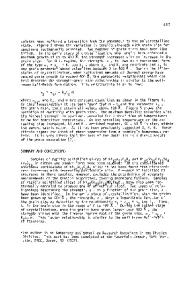Substructure strengthening in dispersion-strengthened nickel alloys
- PDF / 3,787,284 Bytes
- 13 Pages / 612 x 792 pts (letter) Page_size
- 33 Downloads / 410 Views
E A R L I E R models of dispersion strengthening offer no completely satisfactory explanation of the high strength at elevated temperatures. The dislocation-particle interaction m o d e l is not tenable at high temperatures w h e r e cross-slip and c l i m b processes proceed readily, and the p r e c i s e role of stored energy is not c l e a r in a m o d e l for high temperature strength. Preston and Grant ~found that the strength of extruded Cu-A1203 and Cu-SiO2 alloys could not be related simply to the d e g r e e of dispersion and they postulated that it was r e l a t e d to retained strain energy. The s t r a i n energy was developed during the extrusion process and the presence of the dispersoid impeded dynamic recovery. White and Carnahan z concluded similarly that the strength of NiThO2 at ambient temperature was largely a function of stored energy resulting from extrusion followed by various strain-anneal cycles. The measurement of stored energy in dispersion-strengthened copper has been reported by Chin and Grant 3 who used a c a l o r i m e t r i c method t o m e a s u r e the energy r e l e a s e d during high temperature annealing. Only at temperatures high above the n o r m a l recrystallization temperature of pure copper was the energy r e l e a s e observed. A calculation of the interfacial free energies for surfaces, g r a i n boundaries, stacking faults, and twins has been made in Ni, Ni-ThO2, and Inconel 600 by M u r r , Smith, and Gilmore 4 from the observation of interface intersection morphologies. The importance of dislocation substructure has been noted by yon Heimendahl and Thomas 5 and by Wilcox and Clauer. 6 T h e s e authors associated the strength of Ni-ThO2 w i t h the presence of a highly stable dislocation substructure that was not removed M.A. CLEGG is Manager, Physical Metallurgy Research, Sherritt Gordon Mines Ltd., Fort Saskatchewan, Alberta, Canada. J. A. LUND is Professor, Department of Metallurgy, University of British Columbia, Vancouver, B.C., Canada.The paper is basedupon a thesis submitted by M.A. CLEGG in partialfulfillment of the requirementsofthe degree of Doctor of Philosophy at the University of British Columbia. Manuscript submittedJanuary 25, 1971. METALLURGICAL TRANSACTIONS
at elevated temperatures and which they r e g a r d e d as indicating a high s t o r e d energy. Von Heimendahl and Thomas were not able to r e l a t e the strength of Ni-ThO2 to the g r a i n size u s i n g the HallT-Petch8 relationship. S i n c e 1966 a dispersion-strengthened nickel-chromium-thoria alloy 9 has been commercially available in addition to the e a r l i e r nickel-thoria alloy 1° and this has stimulated r e s e a r c h on the combined strengthening of an element in solid solution and a dispersoid. Webster 1~ has recently reported a study of the various strengthening mechanisms in dispersion hardened Nichrome. In the present study a family of alloys comprising b o t h s i n g l e component and solid solution parent m a t r i c e s , with and without dispersion strengthening, was
Data Loading...











